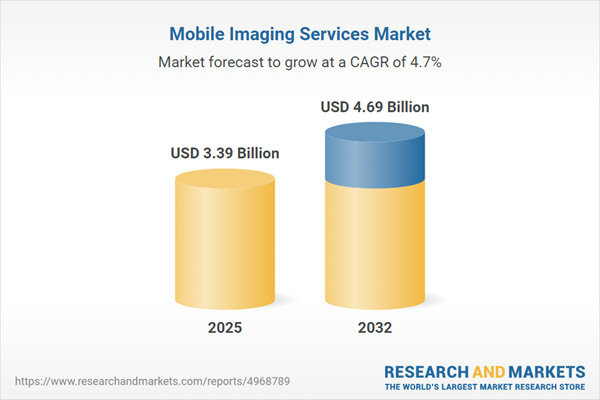Speak directly to the analyst to clarify any post sales queries you may have.
The mobile imaging services market is transforming healthcare organizations’ approach to diagnostics, offering greater flexibility and responsiveness for diverse patient care needs. Designed to enhance care delivery, continuity, and reach, mobile imaging solutions are becoming central to forward-thinking leadership strategies.
Market Snapshot: Mobile Imaging Services Market
The global mobile imaging services market is forecast to rise from USD 3.24 billion in 2024 to USD 3.39 billion in 2025, reaching an expected value of USD 4.69 billion by 2032. This represents a 4.72% compound annual growth rate (CAGR). Steady expansion is driven by sustained demand for more accessible, patient-centric diagnostics. Demographic trends, the prioritization of care accessibility, and heightened needs for rapid diagnostic turnaround are prompting healthcare organizations to reevaluate diagnostic strategies. Ongoing advancements in portable imaging technologies are empowering care teams to deliver complete diagnostic services even where fixed infrastructure is limited. Regulatory developments continue to expand the role of mobile imaging as core to evolving healthcare models.
Scope & Segmentation
- Imaging Types: Computed tomography (CT), magnetic resonance imaging (MRI) in both open and closed designs, analog and digital X-ray solutions, mammography, nuclear imaging, and diverse ultrasound modalities (2D, 3D/4D, Doppler) address a breadth of diagnostic requirements. These tools support routine examinations as well as targeted specialist assessments across multiple medical fields.
- Service Types: Diagnostic, emergency, interventional, monitoring, and screening solutions are available. This breadth supports organizations managing acute events, facilitating prevention strategies, and supporting ongoing patient management directly at the point of care.
- End Users: Hospitals, ambulatory surgical centers, specialized diagnostic imaging centers, nursing homes, geriatric and rehabilitation settings, home healthcare teams, military medical staff, and sports clinics utilize mobile imaging to enhance clinical delivery. This broad adoption helps extend services into both urban and underserved locations.
- Applications: Clinical integration focuses on cardiovascular, neurological, obstetric and gynecological, oncology, orthopedic, pulmonary, urological, and general radiology diagnosis. Each area benefits from nimble, on-site imaging that supports more effective treatment paths and timely clinical decisions.
- Mode of Operation: Both contract-based and standalone mobile imaging models are available, supporting organizations of all sizes—from large hospital systems to specialized clinics and smaller healthcare businesses—seeking operational flexibility.
- Regional Coverage: The mobile imaging landscape is established across the Americas, Europe, Middle East and Africa, and Asia-Pacific. Each region aligns technology deployment to unique infrastructure and health priorities, ensuring adaptations to local market dynamics and regulatory settings.
Key Takeaways
- Directly providing imaging at patient locations supports better care continuity for urgent, chronic, and preventive healthcare settings by reducing unnecessary patient movement.
- Advanced integration of artificial intelligence and secure cloud platforms enhances workflow efficiency and enables seamless collaboration among geographically dispersed clinical teams.
- Ongoing progress in device portability, wireless connectivity, and intuitive system design underpin the deployment of mobile imaging in nontraditional environments, strengthening reliability and operational reach.
- Comprehensive data privacy strategies and strict compliance with regulatory protocols are crucial as distributed diagnostic services become more prevalent in decentralized care models.
- Collaborations with technology and software partners equip organizations to navigate regulatory adjustments and streamline workflow processes, sustaining efficient and compliant operations.
- Expanding the reach of imaging in remote and underserved communities aids in reducing health disparities, supporting more inclusive and patient-oriented care delivery models.
Tariff Impact: Navigating US Policy Changes
Alterations in US tariff policy have led healthcare organizations to reassess supplier networks and foster regional supply chains for mobile imaging services. Diversification of procurement strategies, as well as refined contract management, now serve as tools to build resilience and maintain consistent diagnostic service levels amid regulatory change.
Methodology & Data Sources
This analysis draws upon in-depth interviews with healthcare executives, comprehensive reviews of peer-reviewed research, and real-time monitoring of relevant regulatory updates. These methods, combined with industry expert insights, ensure reliability and relevance for senior decision-makers evaluating mobile imaging strategies.
Why This Report Matters
- Offers actionable insights that allow leadership teams to anticipate operational and market challenges and capitalize on new opportunities within the mobile imaging services landscape.
- Provides targeted guidance for integrating new imaging technologies, managing compliance, and maintaining agile diagnostic operations responsive to evolving clinical needs.
- Facilitates workforce and infrastructure planning for organizations aiming to remain competitive and responsive in shifting healthcare environments.
Conclusion
Mobile imaging services enable organizations to extend diagnostic capabilities and adapt to dynamic care delivery models. Adoption of these solutions supports improvements in accessibility and operational efficiency across healthcare networks.
Additional Product Information:
- Purchase of this report includes 1 year online access with quarterly updates.
- This report can be updated on request. Please contact our Customer Experience team using the Ask a Question widget on our website.
Table of Contents
3. Executive Summary
4. Market Overview
7. Cumulative Impact of Artificial Intelligence 2025
Companies Mentioned
The companies profiled in this Mobile Imaging Services market report include:- RadNet, Inc.
- Alliance HealthCare Services, Inc.
- Radiology Partners, Inc.
- MedQuest Associates, P.C.
- National Medical Services Radiology, LLC
- Nova Medical Imaging, Inc.
- Proscan Imaging, LLC
- Accurate Imaging Inc.
- Akumin Inc.
- Cobalt Imaging Center
- DMS Health Technologies, Inc.
- EMS Healthcare
- Front Range Mobile Imaging, Inc.
- I-MED Radiology Network
- InHealth Group Limited
- Medica Reporting Ltd.
- Mediscan Diagnostic Services
- MedRay Imaging
- Nuffield Health
- Premier Diagnostic Services
- Shared Medical Services, Inc.
- Shields Health Solutions
- SimonMed Imaging
- Touchstone Imaging
- TridentUSA Health Services
Table Information
| Report Attribute | Details |
|---|---|
| No. of Pages | 184 |
| Published | October 2025 |
| Forecast Period | 2025 - 2032 |
| Estimated Market Value ( USD | $ 3.39 Billion |
| Forecasted Market Value ( USD | $ 4.69 Billion |
| Compound Annual Growth Rate | 4.7% |
| Regions Covered | Global |
| No. of Companies Mentioned | 26 |









